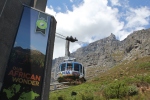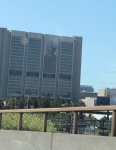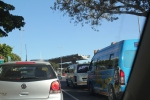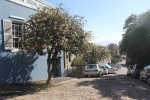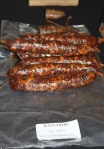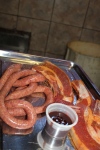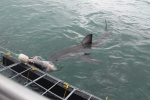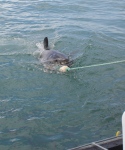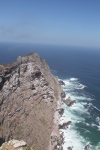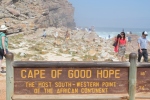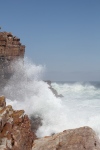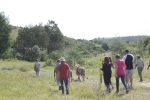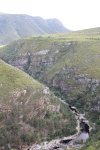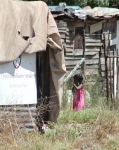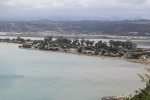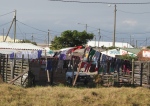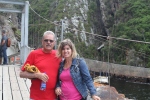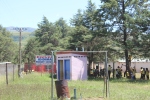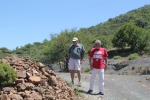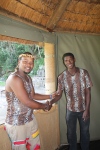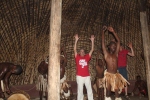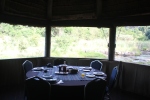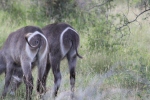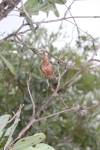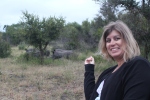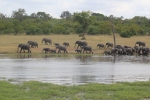It has been the most interesting 48 hours, illustrating the incredible contrast that is South Africa. We began in ‘heaven,’ amidst the flowering landscape and attentive service at Cathedral Peak resort– gourmet dining, poolside pina coladas, speedy internet, spa, lawn bowling(!) – all within the backdrop of the incredible majesty of the Drakenberg Mountains.
Our guide connected with a resort employee, Moses, who agreed to bring us to his home in the mountain village. We set off and after a short ride, were asked to park our car along the rugged dirt road and walk up the hill to a cluster of four small, clay thatch-roofed buildings. Three were square and one was round. Three goats and a half-blind dog wandered around the dusty plot of land. There was a grapevine terrace (a spot of cool shade!), and a small vegetable garden with maize (corn) and some cannabis(!). We were introduced to a middle-aged woman, who invited us into the largest of the square structures. We sat on small stools. Two more men, evidently the woman’s husband and another, joined us. They explained the kitchen, the roles of men and women and the process of making beer, which we tasted.
Next, we went to the round hut. The men were directed to one side of the room and the woman (me) went to the other. We were told how the purpose of this building was to honor and connect with the ancestors. Before any celebration, meat and beer are presented first to the ancestors. On bended knees, the men light and inhale herbs, calling forth the spirits as they seek advice and guidance. Evidently, women aren’t allowed inside unless all the men are gone. Then it’s the responsibility of the oldest woman relative.
I was somewhat disappointed that there weren’t any children around. They were all at school. During our travels, we had seen so many kids on the road, all in uniforms taking the often long walk to school. In the late afternoon, they’d be alongside the roads waving at the cars, hoping for some “sweets.” I was excited to find that our next stop would be a rural school. After getting permission from the two teachers (who didn’t speak English), we went into the classroom of forty three to four year olds. The kids were adorable and very well behaved. They were extremely curious about their visitors and many were afraid because they had never seen a white person before. The classroom was sparse yet tidy. Like any preschool, letters were written on the blackboard. But unlike the schools I am used to, there were few books and toys. We asked some questions through our guide. The kids learn through their own language for the first few years. They begin wearing uniforms in first grade. Meals are often provided to the kids through a social worker. Before we left, we were treated to a little song and dance! The language may be different but the enthusiasm and smiles were like any group of preschoolers. We left candy with the teachers and took down their address so we could send some coloring books when we get back home.
As we approached various villages, we encountered colorful crowds. Today was Pension Payday! Once a month, the government goes around to all the villages disbursing pension payments to those 65 and older — IN CASH! Over 16 million people are eligible for these pensions. In the rural villages and towns, markets pop-up selling produce, clothing and other goods. It’s a vital component of the South African economy. One of the towns we went through was Greytown. Juxtaposed with the crowded and chaotic town center was the wealthier side of town. As we lunched at the country club golf course, we watched local soccer moms speeding along in their SUVs after picking up their kids from private school.
Far away from town, we came along a large pile (cairn) of small rocks just off the road. Our guide Paul told us there were two explanations as to what it represented. The first was that we were entering a Zulu tribal area and anyone passing through had to spit on a rock and add it to the pile “to ward off ill luck and propitiate the spirits.” The other was directed at their enemies. As they passed the cairn, they were given two hours before they would be hunted down – yikes!
Our next encounter involved rocks, as well. The police had set up a roadblock to warn drivers about trouble in the next town. He suggested we turn around as citizens were violently protesting the lack of services (water, electricity). Paul was familiar with the roads and said he knew of another road just before that town and so we proceeded. There was no protest (“Only believe half of what you hear in Africa” – Paul) but just before the NEXT town, rocks appeared in the road, then a tree, then a few more boulders. We kept driving and dodging until Paul flagged down a heath services truck coming in the opposite direction. They informed us that the road ahead was blocked and that the locals had taken out the bridge. Needless to say, we had to find an alternate route. We were fortunate Paul knew the backroads and before long, we were back on track.
The area is going through a severe drought and many of the rivers are dried up. Every once in a while, we’d pass a cluster of large barrels. Paul told us that a truck comes by and fills them with water. At one point, a young woman was filling a container to take home. Her face was covered with clay (natural sunscreen!) and she cheerfully agreed to take a photo with me.
We passed through many more poor communities before approaching an opulent, gated area of countless uniform homes surrounded by manicured grounds. Our guide said the compound belonged to President Zuma who had built it to house his six wives and entourage. Several members of the current Congress were questioning its excessive price tag.
More driving lead to what would be the day’s final destination, Simunye Zulu Lodge, and another rock story. As we pulled up to the entrance, we were met by two young men in native costume. Lackie, the manager, said that recent rains and a tractor had taken out their road. Would we mind if we left our car at the neighbor down the road? Having no choice, we drove the half mile through the sugar fields and left the car. Frank and I crammed into the front seat of the pickup with Lackie. Paul, the other young fellow and our luggage rode in the back. It took forty-five minutes to drive 4-kilometers down a rocky, extremely rutted dirt road to reach the lodge! The rooms were nice so we settled in to freshen up. Unfortunately, our room had no running water. We had wanted a place that wasn’t too polished and this was it. No longer run by a major hotel chain, this “cultural experience” had been taken over by community through a government initiative. The grounds needed much work but the young people that worked there more than made up for it. They couldn’t have been kinder or more enthusiastic.
Curiously, there were no older people on the property. We were told that the “elder” was a polygamist and tonight he was with his “other” wife. The show was in a very warm room but we were happy to participate. Paul said the dancing was some of the most authentic and best he’d experienced. We greatly enjoyed it and followed the dancers to the dining area for the simply prepared food. There was only one other couple beside us (Danes) and we ate together. That night, we sprayed for bugs and tried to sleep.
Although they forgot to bring water for toilets before we went to bed, Lackie and Henry were outside at 7am with a bucket and sincere apologies. We had breakfast and learned more about Zulu ways and history. Frank tossed a spear and I ground some maize. In their interpretation, the round room was used to connect with the ancestors, but was also the home of the most honored member of the community, the grandmother. I took lots of pictures. The staff gathered around the camera after each shot to see them and I promised to send copies.
We packed up and headed back to the pickup. Somehow the Danes had managed to drive their car down(!) so they followed us out. It was a quiet, reflective drive back to Durban. “In Africa, always expect the unexpected,” said Paul.
He dropped us off at the Fairmont Zimbale, a sprawling 5-star resort along the ocean.








